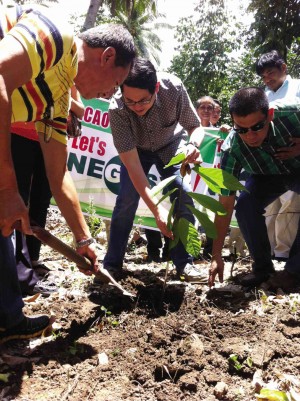
ASIDE from its cash potential, cacao can also play a part in greening Mindanao. Sen. Bam Aquino digs alongside Task Force Mapalad cacao farmers. GERMELINA LACORTE
About 25 kilometers from Davao City, schoolchildren continue to go to Vinzons Elementary School in Barangay Manuel Guianga, breathing in harmful farm chemicals in the air, the environment group Interface for Development Intervention (Idis) claimed.
Ann Fuertes, Idis executive director, said random air samples taken from the areas surrounding the school in 2011 and 2012 showed different levels of contamination from banned and currently used farm chemicals.
She said this was why Idis chose the school, which sat next to and in front of pineapple and banana plantations, as its “Treevolution” site, where the group would plant over a thousand trees in an hour during the simultaneous, Mindanao-wide tree-planting event scheduled on Sept. 26.
Joselin Marcus Fragada, regional director of the Department of Environment and Natural Resources (DENR), said “Treevolution: Greening MindaNow” sought to break the 1.9 million-tree Guinness World Record for most trees planted in an hour currently being held by India.
Fragada said Idis sought to plant 4.6 million seedlings of trees in the hour-long, simultaneous, Mindanao-wide event.
For Idis, a thousand trees to be planted on the 2-hectare lot at the back of the school and another row of trees in front would, at least, serve as buffer for the school against the pesticide drifts from surrounding farms.
“We need to plant trees so that schoolchildren can’t breathe them (pesticides) in, and we are going to partner with schools so that they will take care of the trees,” Fuertes said.
“The trees cannot immediately save the schoolchildren from pesticide drifts from neighboring banana and pineapple plantations because it will take time for the trees to grow, but we hope that once they’ve grown, the trees we’re going to plant will eventually serve as buffer against the onslaught of poison in the air from neighboring pesticide-dependent plantations,” Fuertes said.
Fragada said the planting of 4.6 million trees, aimed at beating the 1.9 million trees planted by India on Aug. 15, 2011, would serve as Mindanao’s gesture of unity in helping address climate change and, hopefully, mitigate its impact.
“I’m fairly confident that the record will be broken,” Fragada said. “It will be a proper statement for Mindanao to unify itself in addressing climate change and contribute to its mitigation.”
The 4.6 million trees will be planted in 9,200 ha, including areas marked for tree planting by the government’s National Greening Program (NGP).
The activity, which is coordinated with the Mindanao Development Authority (Minda), will mobilize at least 185,440 people, most of them from local government units and the private sector. Participants should be at least 17 years old, Fragada said.
“This is not only a global event, but a historical event as well, because we plan to involve different local government units all over Mindanao to reach our target,” Fragada said.
The target of the NGP, now in its fourth year and supposed to end in 2016, is at least 8 million trees this year involving some 16,000 ha of land nationwide.
“The campaign to plant 4.6 million trees will not be merely a Guinness attempt,” Fragada said.
“It will create awareness among the people in Mindanao of what we can do if we work together,” he added.
The activity also hopes to reclaim the country’s Guinness record for most trees planted in a single day.
“If Mindanao is successful in the world [record] attempt, it will be the second world-record breaker in the Philippines,” Fragada said.
On Feb. 23, 2011, Camarines Sur province bagged the world record for most trees planted in a single day when some 6,893 participants planted 64,096 seedlings on a 32-ha property. The record, however, was short-lived as India, on Aug. 15 of the same year, planted 1.94 million trees across 408 locations.
The Treevolution, however, will also help achieve the NGP target of planting trees on 690,815 ha of land to boost the country’s forest cover by at least 30 percent.
Fragada said the activity was not “just another tree planting.”
“We are practically encouraging every Mindanaoan to be part of this endeavor,” Fragada said. “We hope to solicit greater public participation and appreciation of the government’s efforts in growing back some of the forests of Mindanao.”
Minda Secretary Luwalhati Antonino said the activity would give people a chance to be a part of a larger effort to reforest Mindanao. Antonino said the project might look insurmountable at first, but it could be done “with a well-planned and synchronized mobilization, coordination and information campaign.”
Aside from different tree varieties, a million cacao seedlings will also be distributed for the event, Minda executive director Janel Lopoz said.
“If planted, the cacao seedlings will produce some 1,140 metric tons of cacao each season and this will be a big help to the problem of cacao shortage in the country,” Lopoz said.
Fuertes said that on the 2-ha lot that organizers had chosen in Barangay Manuel Guianga, they preferred to plant indigenous fruit-bearing trees. She said schools near plantations should be included in the government’s greening program to protect the children from pesticide drifts from commercial farms. With a report by Judy Merquita